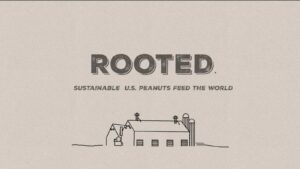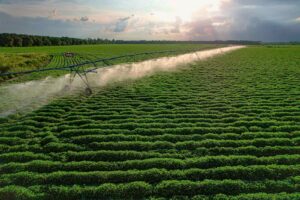by Bob Parker, President & CEO at National Peanut Board
Originally shared on LinkedIn.com
You may have seen headlines about the Intergovernmental Panel on Climate Change (IPCC) report around the state of the environment. It sounds a “code red” for humanity. There may not be agreement on the causes, manmade or natural, but many farmers I talk to have seen climatic changes on their own farms. Without a doubt, our industry and farmers everywhere are and will be impacted by rising temperatures, regardless of cause.
So, what does this mean for the peanut industry? Long before intergovernmental reports, farmers were concerned with caring for the land because they knew it meant being able to farm into the future. They want to leave the farm to their children, so investing in conservation research and sustainable practices means investing in their future and their children’s.
However, as evident by the world around us and recent news, the stakes are getting higher. And as an industry, we have an opportunity to be a part of the sustainability solution and an obligation to continue finding ways to be even more environmentally friendly.
Today more than ever, consumers are eager to know where their products come from and their environmental impact. Peanuts have an incredible and evolving sustainability story and we must come together to tell it. Here are some places to start.
Meet Consumer Expectations
According to a Havas Group Worldwide study called “Project Superbrand: 10 Truths Reshaping the Corporate World,” two in three consumers believe brands have as much responsibility as governments in driving social change like sustainability. (1)
Conversely, they don’t put the burden of environmental responsibility solely on the shoulders of the government or brands. In fact, 42 percent of consumers believe their choices have a significant to moderate impact on the environment, and many wish they understood more about the sustainability of products so they could make more informed decisions. (2)

This is an opportunity for the peanut industry. We need to make it easier for consumers to participate in the sustainability movement and show them how consuming peanuts and peanut butter is contributing to a healthier environment.
The toughest critics will be our younger consumers – Gen Z. For this generation, born after 1996, the environment is their number one concern. It is no longer an option for a company to make a social impact, they expect it. Ninety percent of Gen Z believe companies must act now to help social and environmental issues. And they aren’t taking your word for it. Seventy five percent will do research to ensure companies are backing up their claims. (3) It isn’t just Gen Z. Millennials, Gen X and Boomers alike state the environment is of importance to them.

Share About Our Sustainable Crop
We know consumers want to hear our industry’s sustainability story. Lucky for us, that’s an easy tale to tell, so easy in fact that we need to do a better job of remembering to do it. Peanut farmers are making continuous improvements in water conservation, chemical reduction and land resource management. Compared to other major nuts, peanuts have one of the smallest carbon footprints.
Make Sustainability More Measurable

The peanut industry recognizes the growing importance of communicating the sustainability of our crop, as well as implementing farming practices that increase soil health. At its meeting in July, the American Peanut Council Sustainability Initiative created the Peanut Trust Protocol, which will set standards for more sustainably grown peanuts.
The Peanut Trust Protocol will offer brands and retailers annual data from its farms that can be used to show measurable progress towards corporate sustainability pledges and commitments, as well as verify facts for consumers who aren’t just taking your word for it anymore. The Peanut Protocol is modeled after the Cotton Trust Protocol and since many peanut farmers also grow cotton, they will recognize a synergy between the two.

The Protocol also gives farmers a platform to showcase their work toward sustainability, by showcasing the journey with best practices and success stories, rather than simply when the goal is reached. By creating a framework for more sustainably grown peanuts, the industry is choosing to lead rather than follow.
Embrace Regenerative Agriculture
There’s been a larger focus on regenerative agriculture, a term that is growing in recognition, but has no concrete definition. In fact, a research review at the University of Colorado looked at 229 scholarly articles and 25 practitioner websites and found half didn’t define the term when they used it. (4)

With no consensus on the actual definition of regenerative agriculture, it is up to us, the peanut industry to play a role, as farmers, in defining regenerative agriculture as it applies to peanuts. We need to get farmers on board, help them determine how to measure, and how to educate both company executives and consumers.
At the core, regenerative agriculture is really about soil health – keeping carbon in the ground, reducing tillage, using cover crops, and increasing biodiversity. It’s not about organic agriculture, as some groups claim. Conventional farming can use regenerative practices just as well.
There are several potential benefits for farmers for implementing regenerative practices. First, healthy soil means healthier yields on crops. There are also cost savings from reduced use of chemicals. Second, there is a growing appetite for selling carbon credits. For example, Land O’Lakes’ sustainability business, Truterra, launched a program called TruCarbon that will help farmers generate and sell carbon credits to private sector buyers, such as Microsoft. (5)
Additionally, the Growing Climate Solutions Act, which passed in the Senate in June, would have the U.S. Department of Agriculture set up a certification program to help private landowners navigate the complex field of private-sector carbon market programs. (6)
Lastly, while they may not fully understand what regenerative agriculture is, consumers are demanding it. In fact, nearly half of U.S. consumers are likely to change what they buy depending on the company’s commitment to the environment, and that frame of mind isn’t changing anytime soon. Consumers are predicted to spend up to $150 billion on sustainable products in 2021. (7)
There are still many hurdles. For systems to be successful, farmers need to understand the return on investment versus continuing to layer on the regulatory framework. Right now, the biggest opportunity is with government, but we need a true business analysis across the entire industry and less focus on government subsidies. This is where company partners and NGO’s can help.
And simply, we need more farmers to continue the legacy. The average age of today’s farmer is almost 58 years old (8) and few in the younger generations are picking up the torch. For those already in the business, convincing them to transition to regenerative farming practices is a challenge. How can we communicate what regenerative agriculture is when the industry itself has no consensus on the definition?
Beyond Consumption
The peanut sustainability story is far from finished. In fact, it is just the beginning. In a world that is changing by the minute, the humble peanut goes beyond just cuisine. For instance, there is no waste in peanut production. Pelletized peanuts made from the peanut hulls are used for animal feed and fuel. Peanut ‘hay’ made from the vines is used as food for cattle and ground cover or cut back into the land to enrich the soil. And scientists are researching peanut skins, which contain high levels of antioxidants and polyphenols, for emergent uses. (9)
Our Call to Action
In November, more than 190 world leaders will convene in Scotland to discuss a worldwide approach to limiting global warming and no doubt, the information in the IPCC report will be a part of that discussion. In our industry, the Peanut Trust Protocol will be creating standards for sustainability, and we should all be a part of that process, sharing our collective experiences and solidifying our approach.
For our farmers, sustainability practices not only protect the environment, they ensure long-term economic viability for their operations. Without financial stability, there will be little to lure the next generation back to the farm.
We know consumers are hungry where it comes from and who grew it. As the peanut industry continues to explore and innovate new ways to leave a positive impact on the environment, bringing the consumer along on the journey will be critical.
The peanut and peanut butter story is already a great one to tell. We need to tell it more often. It is time to get out there and share more with consumers about both to learn about the food they eat, the current state, as well as our investments in the future, and get their input. We also need to give our partners the information and tools they need to inform their customers. Investing in environmental sustainability is an investment in the future of our industry.
Resources:
1 www.cavill.com.au/wp-content/uploads/2016/07/13-Havas-Worldwide-March-2015-Project-Superbrand.pdf
2 https://foodinsight.org/2021-food-health-survey/ (download required)
3 www.conecomm.com/research-blog/cone-gen-z-purpose-study
4 https://www.frontiersin.org/articles/10.3389/fsufs.2020.577723/full
6 www.agweb.com/news/policy/politics/senates-growing-climate-solutions-plan-gets-agricultures-backing2
7 www.fooddive.com/news/2018-was-the-year-of-the-sustainable-shopper-nielsen-says/544983/
8 https://www.nass.usda.gov/Publications/Highlights/2019/2017Census_Farm_Producers.pdf




